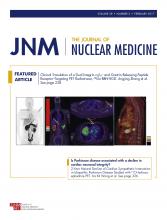TO THE EDITOR: We read with interest the results of the recently published THYROPET study (1), a prospective multicenter diagnostic cohort study testing the hypothesis that a recombinant human thyroid-stimulating hormone (rh-TSH)–stimulated 124I PET/CT scan can identify patients with a negative thyroxine withdrawal (T4WD) posttherapy 131I scan and avoid futile treatment in patients with suspected recurrence of differentiated thyroid carcinoma. The trial was terminated prematurely because of a high number of false-negative rh-TSH–stimulated 124I PET/CT scans, which would preclude potential therapeutic benefit from 131I therapy. Although this may be interpreted as a rebuttal of the theranostic approach and affirmation of the established practice of empiric 131I, we agree with the authors’ conclusion that “124I PET/CT remains the most rational strategy to reduce futile 131I therapies” despite this statement’s apparent conflict with their actual study findings. The explanation of this result will be critical to guide the use of 124I PET/CT for management of advanced thyroid cancer.
In particular, we would like to focus on the very different clinical implications arising from the possible technical and biologic explanations for the false-negative rh-TSH–stimulated 124I results. Radioiodine imaging is a classic theranostic investigation, whereby the distribution of iodine uptake and retention within tumor is used to predict the response to a therapeutic administered activity of 131I. A key advantage of 124I PET/CT imaging is the opportunity to perform prospective dosimetry to more accurately predict this response (2). In this context, it is highly unlikely that a necessarily faint focus of uptake below the resolution of 124I PET but visible on post-131I imaging would deliver a clinically meaningful dose of radiation. Thus, if technical differences were the only explanation for the high false-negative rate of 124I PET/CT, then it remains an appropriate screening investigation for this indication as the risks of high-dose 131I therapy are likely to outweigh the modest benefits due to unfavorable radiation dosimetry.
However, a recently published phantom study (3) confirms that there is no appreciable technical difference in detectability for even small spheres (<10 mm) at this administered activity (74 MBq of 124I) on scanners using point-spread function model-based resolution recovery and time-of-flight technology. We note that some but not all THYROPET study centers had time-of-flight technology, and thus, knowledge of the number of patients imaged using this protocol is necessary to better interpret the results of this study. Different imaging times are another potential technical explanation for uptake that was seen on delayed posttherapy scans (5 d) but missed on early (24 h) 124I imaging (4). However, this is unlikely to be relevant because of the dual-time-point 24- and 96-h acquisitions utilized in the THYROPET study.
In contrast, it remains plausible that the false-negative 124I PET/CT scans reflect different biologic tumor responses to TSH stimulation from rh-TSH and thyroxine withdrawal. The authors appropriately discuss this possibility with numerous published intrapatient case studies. We also note that in the subset of THYROPET cases, there was one patient who underwent 124I PET/CT after both rhTSH and T4WD, and this patient had 23 times greater 124I retention after T4WD. If this finding were confirmed in a large, prospective, intrapatient 124I study, there would be profound clinical implications for the management of metastatic thyroid cancer, given the widespread use of off-label rh-TSH stimulation for both diagnostic 124I and therapeutic 131I therapy in this setting.
We believe it is more plausible that biologic differences between rh-TSH and T4WD stimulation of recurrent thyroid cancer explain the THYROPET results with significant clinical impact. To the extent that technical factors associated with 124I imaging explain the THYROPET study findings, we believe that they are unlikely to affect its role as a theranostic test in this setting.
Footnotes
Published online Aug. 18, 2016.
- © 2017 by the Society of Nuclear Medicine and Molecular Imaging.







